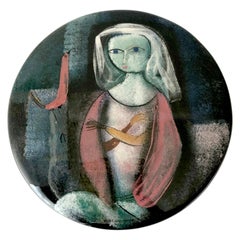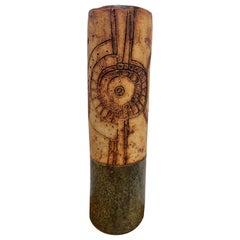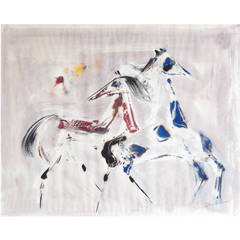Polia Pillin On Sale
Vintage 1960s American Mid-Century Modern Ceramics
Ceramic
Vintage 1950s American Mid-Century Modern Ceramics
Ceramic
Vintage 1950s American Mid-Century Modern Decorative Boxes
Ceramic
People Also Browsed
Mid-20th Century British Brutalist Vases
Ceramic, Pottery
Vintage 1950s American Mid-Century Modern Wall-mounted Sculptures
Metal
Vintage 1960s French Mid-Century Modern Jewelry Boxes
Enamel
Early 20th Century American Art Nouveau Planters and Jardinieres
Pottery
Vintage 1950s American Mid-Century Modern Historical Memorabilia
Aluminum
Vintage 1920s Dutch Art Deco Vases
Pottery
Early 20th Century Danish Art Nouveau Vases
Pottery
Early 20th Century Chinese Qing Ceramics
Ceramic
20th Century Louis XVI Grandfather Clocks and Longcase Clocks
Bronze
Vintage 1920s American Art Deco Planters, Cachepots and Jardinières
Ceramic
Vintage 1940s Danish Vases
Early 20th Century Chinese Qing Ceramics
Ceramic
Mid-20th Century American Hollywood Regency Vases
Lucite
Mid-20th Century Swedish Vases
Crystal
21st Century and Contemporary Unknown Anglo-Japanese Ceramics
Stoneware, Ceramic, Pottery
Antique 19th Century French Bessarabian Vases
Ceramic, Pottery
Recent Sales
Vintage 1960s American Mid-Century Modern Drawings
Watercolor
20th Century American Mid-Century Modern Ceramics
Ceramic
Vintage 1950s American Mid-Century Modern Pottery
Ceramic
Polia Pillin for sale on 1stDibs
Polia Pillin, née Sunockin, was born on September 1, 1909, in Częstochowa. She came to Chicago from Poland in 1924 to work an industrial job that allowed her to support her family overseas. She began to take art classes at the Jewish People's art institute in the evenings and dreamed of supporting herself as an artist. In 1938, she married William Pillin, who had fled persecution in Ukraine with his family and settled in Chicago and they lived in New Mexico. After the birth of their first child, they returned to Chicago, where she had her first show of paintings at the Chicago Art Institute. She became fascinated with clay and in 1946 she took a six-week course in pottery which was her only formal training. She set up a studio in her kitchen, complete with a wheel and electric kiln and soon her innovative works were in high demand. By the 1960s, the Pillins, now collaborating on throwing pots and developing glazes, were selling pottery faster than they could produce it. Polia Pillin's pieces are instantly recognizable. Her technique involves painting on pieces with colored clays while they were still wet and then double-firing using a transparent glaze which produced a high gloss finish. Her pieces, both paintings and pots, feature whimsical figures of people and animals. Her style was informed both by her Eastern European heritage and by her surroundings in New Mexico. She has won numerous awards from Los Angeles County Art Institute in 1949, Syracuse Museum of Fine Art in 1950 and California State Fair in 1951.
A Close Look at Mid-Century Modern Furniture
Organically shaped, clean-lined and elegantly simple are three terms that well describe vintage mid-century modern furniture. The style, which emerged primarily in the years following World War II, is characterized by pieces that were conceived and made in an energetic, optimistic spirit by creators who believed that good design was an essential part of good living.
ORIGINS OF MID-CENTURY MODERN FURNITURE DESIGN
- Emerged during the mid-20th century
- Informed by European modernism, Bauhaus, International style, Scandinavian modernism and Frank Lloyd Wright’s architecture
- A heyday of innovation in postwar America
- Experimentation with new ideas, new materials and new forms flourished in Scandinavia, Italy, the former Czechoslovakia and elsewhere in Europe
CHARACTERISTICS OF MID-CENTURY MODERN FURNITURE DESIGN
- Simplicity, organic forms, clean lines
- A blend of neutral and bold Pop art colors
- Use of natural and man-made materials — alluring woods such as teak, rosewood and oak; steel, fiberglass and molded plywood
- Light-filled spaces with colorful upholstery
- Glass walls and an emphasis on the outdoors
- Promotion of functionality
MID-CENTURY MODERN FURNITURE DESIGNERS TO KNOW
- Charles and Ray Eames
- Eero Saarinen
- Milo Baughman
- Florence Knoll
- Harry Bertoia
- Isamu Noguchi
- George Nelson
- Danish modernists Hans Wegner and Arne Jacobsen, whose emphasis on natural materials and craftsmanship influenced American designers and vice versa
ICONIC MID-CENTURY MODERN FURNITURE DESIGNS
- Eames lounge chair
- Nelson daybed
- Florence Knoll sofa
- Egg chair
- Womb chair
- Noguchi coffee table
- Barcelona chair
VINTAGE MID-CENTURY MODERN FURNITURE ON 1STDIBS
The mid-century modern era saw leagues of postwar American architects and designers animated by new ideas and new technology. The lean, functionalist International-style architecture of Le Corbusier and Bauhaus eminences Ludwig Mies van der Rohe and Walter Gropius had been promoted in the United States during the 1930s by Philip Johnson and others. New building techniques, such as “post-and-beam” construction, allowed the International-style schemes to be realized on a small scale in open-plan houses with long walls of glass.
Materials developed for wartime use became available for domestic goods and were incorporated into mid-century modern furniture designs. Charles and Ray Eames and Eero Saarinen, who had experimented extensively with molded plywood, eagerly embraced fiberglass for pieces such as the La Chaise and the Womb chair, respectively.
Architect, writer and designer George Nelson created with his team shades for the Bubble lamp using a new translucent polymer skin and, as design director at Herman Miller, recruited the Eameses, Alexander Girard and others for projects at the legendary Michigan furniture manufacturer.
Harry Bertoia and Isamu Noguchi devised chairs and tables built of wire mesh and wire struts. Materials were repurposed too: The Danish-born designer Jens Risom created a line of chairs using surplus parachute straps for webbed seats and backrests.
The Risom lounge chair was among the first pieces of furniture commissioned and produced by legendary manufacturer Knoll, a chief influencer in the rise of modern design in the United States, thanks to the work of Florence Knoll, the pioneering architect and designer who made the firm a leader in its field. The seating that Knoll created for office spaces — as well as pieces designed by Florence initially for commercial clients — soon became desirable for the home.
As the demand for casual, uncluttered furnishings grew, more mid-century furniture designers caught the spirit.
Classically oriented creators such as Edward Wormley, house designer for Dunbar Inc., offered such pieces as the sinuous Listen to Me chaise; the British expatriate T.H. Robsjohn-Gibbings switched gears, creating items such as the tiered, biomorphic Mesa table. There were Young Turks such as Paul McCobb, who designed holistic groups of sleek, blond wood furniture, and Milo Baughman, who espoused a West Coast aesthetic in minimalist teak dining tables and lushly upholstered chairs and sofas with angular steel frames.
As the collection of vintage mid-century modern chairs, dressers, coffee tables and other furniture for the living room, dining room, bedroom and elsewhere on 1stDibs demonstrates, this period saw one of the most delightful and dramatic flowerings of creativity in design history.
Finding the Right Decorative Objects for You
Every time you move into a house or an apartment — or endeavor to refresh the home you’ve lived in for years — life for that space begins anew. The right home accent, be it the simple placement of a decorative bowl on a shelf or a ceramic vase for fresh flowers, can transform an area from drab to spectacular. But with so many materials and items to choose from, it’s easy to get lost in the process. The key to styling with decorative objects is to work toward making a happy home that best reflects your personal style.
Ceramics are a versatile addition to any home. If you’ve amassed an assortment of functional pottery over the years, think of your mugs and salad bowls as decorative objects, ideal for displaying in a glass cabinet. Vintage ceramic serveware can pop along white open shelving in your dining area, while large stoneware pitchers paired with woven baskets or quilts in an open cupboard can introduce a rustic farmhouse-style element to your den.
Translucent decorative boxes or bowls made of an acrylic plastic called Lucite — a game changer in furniture that’s easy to clean and lasts long — are modern accents that are neutral enough to dress up a coffee table or desktop without cluttering it. If you’re showcasing pieces from the past, a vintage jewelry box for displaying your treasures can spark conversation. Where is the jewelry box from? Is there a story behind it?
Abstract sculptures or an antique vessel for your home library can draw attention to your book collection and add narrative charm to the most appropriate of corners. There’s more than one way to style your bookcases, and decorative objects add a provocative dynamic. “I love magnifying glasses,” says Alex Assouline, global vice president of luxury publisher Assouline, of adding one’s cherished objects to a home library. “They are both useful and decorative. Objects really elevate libraries and can also make them more personal.”
To help with personalizing your space and truly making it your own, find an extraordinary collection of decorative objects on 1stDibs.






